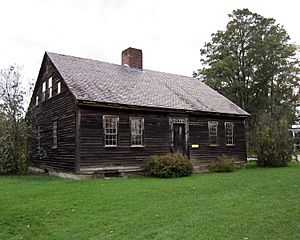Stencil House facts for kids
The Stencil House is a special old home built in 1804. It was part of a large farm in Columbus, New York. This house was designed like a "Capen house," a common style in the 1600s and 1700s. These homes were named after Joseph Capen, who built one of the first in 1692. Capen houses show how British building styles influenced early American homes. Today, Stencil House is an 18th-century historic house museum. You can find it at the Shelburne Museum in Shelburne, Vermont.
Contents
History of Stencil House
Capen houses were usually built around a big fireplace in the middle. This fireplace had openings on many sides to keep the house warm. Like old English homes, they often had three or four rooms downstairs. These rooms included a parlor, a "hall," a kitchen, and sometimes an entryway.
Room Uses in Early Homes
The parlor was a formal room, used for special guests. It was not usually heated in winter unless there was a big event. The kitchen and the "hall" were where families spent most of their time together. The stairs were simple and practical, not a fancy part of the house design yet.
Early American colonists kept the basic layout of European homes. However, they used different materials. They had lots of cheap timber, so they used clapboard siding and shingled roofs. In Britain, homes were often made with mud and thatch.
Changes to Stencil House Interior
Even though Stencil House followed this old plan, its inside looks more like the 1800s. It is not as simple as earlier Capen houses. The parlor is still a reception room for visitors. The "hall" became a formal dining room. Only the kitchen, at the back of the house, kept its original use as a family gathering spot.
Discovering the Stenciling
The house has amazing stenciling in the entryway, parlor, and dining room. These designs make the rooms look even more special. When the museum got the house in 1953, wallpaper covered all the stenciling. Before moving the house, workers carefully took off many layers of old wallpaper. This revealed the beautiful painted decorations underneath.
The artist who did the stenciling did not just make borders. They covered entire walls with designs. They painted directly onto the wooden boards, not on plaster walls. This artwork was likely done between 1810 and 1830. Many of the stenciled patterns in Stencil House are the same as those found in the Farmersville Tavern in Farmersville, New York.
Art on Walls: A Collection
In the 1800s, American homeowners had many ways to decorate their walls. Bright paint colors and wallpaper were available in America as early as 1725. By 1830, thousands of painters offered services like wallpapering, mural painting, and stenciling. The Shelburne Museum has examples of all three types of wall decorations.
Fancy Wallpapers
Wealthy families often bought wallpaper from France and England. They used these papers to decorate formal rooms like parlors and dining rooms. These wallpapers often showed beautiful landscapes. They had bright colors and bold patterns that could be seen even in dim candlelight.
Mural Paintings
Mural painting was another way to decorate walls. It was less expensive than imported wallpaper. Jonathan Poor and his partner, Paine, were artists who painted murals. They traveled around Maine, offering to paint rooms for about $10. The museum has a special over-mantel and chimney-surround that Poor and Paine created around 1830. These paintings were part of a room with landscape murals. They show busy harbors, farms, and forests. They are great examples of this type of art, which is often lost when old buildings are torn down.
Stenciled Designs
In the early 1800s, traveling artists would stencil walls in exchange for a place to stay and food. These artists cut patterns from thin wood or thick paper. They used these patterns to decorate walls and furniture. Stencil House's parlor, dining room, and entryway show many different stenciled patterns. These include grape leaves, vases of flowers, and patriotic eagles. The Dutton House also has its original stenciled patterns in its rooms and hallways.



